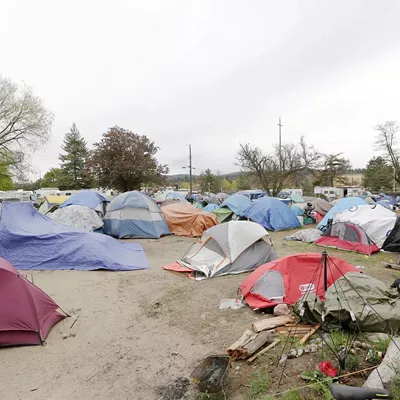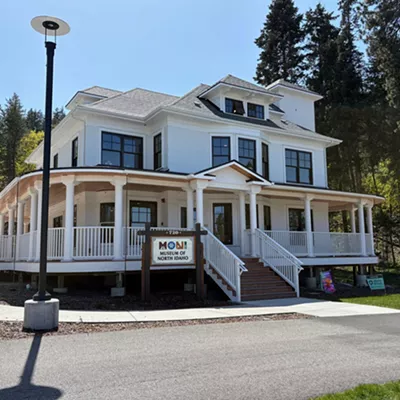Reifsneider's "Axis," for example, appears as a long, tube-like form made of muslin and beeswax, a corner of the X-Y axis draped over another form, which varies depending on where the piece is installed. Like Hesse's 1960s experiments with Fiberglas and latex, Reifsneider uses both organic and manmade materials to create works with Minimalist sensibilities, focused on form.
Reifsneider's sculptures exploit the paradox, seemingly informal as they sprawl across the floor, yet there is nothing casual about her content or process. "I am fascinated by the phenomenological reversibility of world and ground and increasingly drawn to the dual attractive and repellent nature of containment," writes Reifsneider in her artist statement. "Container for Unknit Stitches" combines mohair, cotton, jute, linen and wool in a nearly 3-foot, flattened sphere of rich, softly tufted black textile with a small white circle. It's both absurd and highly serious, a visual "black hole" that is already "full."
Another example of her seemingly incongruous pairings is "One-Eighth of Desire," which is 25 pounds of rubber bands slouched like a mound of fishing net. One end seems faintly suspended from an unseen hook, a palpable tension like a rubber band poised to snap. Reifsnider transforms objects through repetition and layering -- the rubber band no longer functional in its original context -- yet makes them something more. And the title? "Desire" suggests longing and tension. Just like a rubber band poised to snap.
Reifsneider delves into language with pieces like "Fault/Graft." This two-dimensional work shows a dictionary page with all words whited out, leaving only the quaint, Webster-style simulated woodcut illustrations of a fault line and tree graft visible. It's a puzzle, this pairing of fault and graft, this deconstruction of a dictionary, reconstructed to highlight pure visual symbolism, as if the words just get in the way. Reifsneider likes to shift things around on us.
& lt;span class= "dropcap " & L & lt;/span & ike Reifsneider, Susan Skilling's work has a minimalist appeal and, again, echoes Hesse's work, this time her lesser-known abstract drawings and paintings of the late '60s. Skilling's palette is generally muted or monochromatic, her forms geometric. "Moon Dwelling in Light," for example, is a series of glowing, concentric circles in variable shades of gray and pale yellow. "Sun and Moon" reiterates the circular feel but with the impact of a Mark Rothko painting, an almost saturated color field of vibrant red with barely perceptible variations in color and brush-patterning.
Whereas Donald Judd's Minimalist steel sculptures or Frank Stella's "stripe" paintings espouse hard edges and stark shadows, Skilling's work is subtle. She uses gouache (a sort of watercolor, some of which she designed herself) on handmade mulberry paper. The result gives the images a feeling of warmth, like fabric or skin, with edges that blur, blend and overlap with delicate finesse. Visually compelling, they invite closer inspection, offering an opportunity for quiet absorption in Skilling's moments of color and shape.
Where the Minimalists could tend toward austerity or rhetoric, Skilling is reflective and more narrative, with imagery that references water, plant forms, mandalas and rock formations. Seattle gallery owner Greg Kucera, who represents Skilling, describes her work over the past 25 years as a "quiet revelation ... toward a personal enlightenment." He adds: "This is the kind of artist who is led by her inner voice and not by the dictates of fashion or the marketplace."
Ben Mitchell, who along with gallery manager Megan Murphy and several other curators form the group responsible for developing the Saranac Art Space, remarks on this aspect of Skilling's work. Drawn to the idea that artists bring "news to the community from the deep well of the imagination," Mitchell calls Skilling's and Reifsneider's work some of the "most authentic" he's seen in years.
"Both create bodies of work that are deeply contemplative and speak to the interior of the artist," he says, "as opposed to any kind of social or political agenda."
Mitchell first discovered the works of Reifsneider and Skilling more than 10 years ago, and he has followed their development. The challenge for Mitchell -- and an added incentive to view the exhibit-- is how the two bodies of work will play off each other within a small space. Since the work is not yet installed, a gut reaction for me was the connection to Eva Hesse. Yet all this is speculative and -- as I tend to be a context-learner with a need to categorize things -- I know it's just a construct for considering two disparate bodies of work.
Ultimately, we humans want to know what things mean. But the real power of an artwork is what it can do to viewers when they experience it firsthand. That's exciting. And, as Eva Hesse advised: "Don't ask what it means or what it refers to. Don't ask what the work is. Rather, see what the work does."
"New Works by Susan Skilling and Jennifer Reifsneider" opens Friday, Nov. 2 and runs through Dec. 22 at Saranac Art Projects, 25 W. Main St. Hours: Wed.-Sat. 11 am-5:30 pm. Artist reception: Friday, Nov. 2, from 5-8 pm. Free. Visit www.saranacartprojects.org or call 209-2870.
















